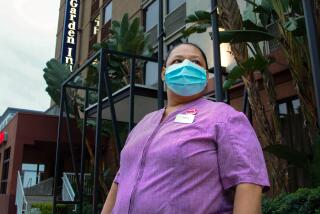Hotel, Airline Linens: Risk Factor or Just Ick Factor?
- Share via
The flight from Chicago to Los Angeles was half-empty, and the flight attendants were offering passengers the airline’s navy blankets and tiny white pillows.
I had three seats to myself, as did the man across the aisle. He grabbed a pillow and a blanket, wrapped up, draped himself across his row and soon was snoring.
I declined the pillow and the blanket--not that I couldn’t have used a nap, but the thought of nestling into a blanket that hasn’t been cleaned between passengers makes me say “ick.” So whenever the temperature at my destination is expected to be 50 degrees or below, I tote a wool pea coat that serves as an all-purpose blanket, lap robe, shoulder wrap and pillow in a pinch.
Is my concern about germs on the road a silly neurosis or a well-founded concern? The answer lies in another question: How often do they clean those airline blankets, pillows, hotel bedspreads and other linens? And is this more a question of aesthetics--call it the Ick Factor--than health?
Airline representatives say it’s common practice to inspect pillows and blankets after each flight and replace and clean them as needed. Examples: On Southwest Airlines, pillow covers are changed daily, blankets when necessary. In first and business class on American Airlines, blankets and pillow covers are replaced after every long-haul international flight. On Qantas, all passengers get fresh linens on those flights.
One airline reservations clerk says that when he flies, he lets his eyes guide him when deciding whether to take a blanket. “If it looks like an unmade bed,” he passes. “If it’s folded better than I can do it,” he says, “I will take it, because it probably means it has been cleaned recently.”
Practices at hotels and motels vary too. The Educational Institute of the American Hotel and Motel Assn. suggests guidelines for linen changing to its members, but they are not mandatory, says Bridgette Redman, a writer and editor with the institute. As a rule, she says, most member hotels and motels change bedsheets after every guest checkout, and the majority also change sheets and towels every day even if guests stay.
Recently, Redman says, more hotels have adopted a practice of not changing sheets during a guest’s stay for conservation reasons. In that case, she says, guests may see a “Good Earthkeeping” card, which alerts them to the practice but invites them to ask for more frequent changes.
What do travelers risk, health-wise, from dirty linens?
Usually nothing serious, says Dr. David Dassey, deputy medical director of acute communicable disease control for the Los Angeles County Department of Health Services. Cold and flu germs, for instance, probably aren’t spread by sharing airline blankets and pillows, he says. The most typical means of transmission for colds and flu, he says, are inhaling the organisms or making contact with them on a surface, then touching one’s eyes, mouth or nose.
Can you pick up lice from an airline blanket or pillow? It’s possible but not probable, Dassey says.
In a hotel room, guests might pick up fleas or lice, Dassey says, but again, it’s unlikely. He advises common-sense measures such as frequent hand washing to avoid picking up germs, and inspecting bed linens for lice or soil.
The germ-wary traveler might take her own pillow or lightweight blanket for the plane. Magellan’s catalog, at Internet https://www.magellans.com, sells space-age Mylar-type wraps for less than $5, along with sleep sacks for hotels where the Ick Factor is sure to be high.
Or our fastidious flier might consider investing in a warm, fuzzy, easy-to-fold coat.
Healthy Traveler appears on the second and fourth Sundays of the month. Kathleen Doheny can be reached at kdoheny@compuserve .com.
More to Read
Sign up for The Wild
We’ll help you find the best places to hike, bike and run, as well as the perfect silent spots for meditation and yoga.
You may occasionally receive promotional content from the Los Angeles Times.





